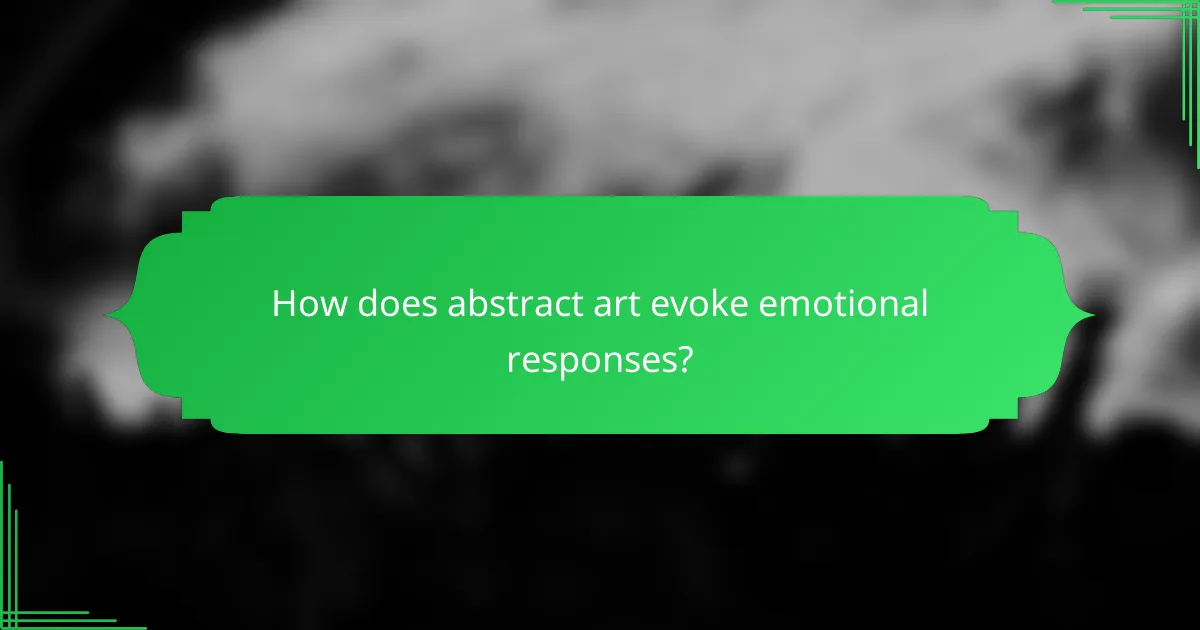Abstract art captivates viewers by provoking emotional responses through its non-representational forms, colors, and textures. As appreciation for unique artistic expressions grows, market demand for abstract pieces has surged, with collectors valuing their distinctive styles and emotional depth.

How does abstract art evoke emotional responses?
Abstract art evokes emotional responses by engaging viewers through non-representational forms, colors, and textures that resonate on a personal level. This art form encourages individual interpretation, allowing emotions to surface based on personal experiences and perceptions.
Use of color psychology
Color plays a crucial role in how abstract art elicits emotions. Different colors can evoke specific feelings; for instance, warm colors like red and orange often generate excitement or passion, while cool colors such as blue and green can create calmness or tranquility. Artists strategically select colors to influence the viewer’s emotional state.
When creating or choosing abstract art, consider the psychological effects of colors. For example, a predominance of yellow might evoke happiness, while darker shades could induce feelings of sadness or introspection. Understanding these associations can enhance the emotional impact of the artwork.
Symbolism and personal interpretation
Abstract art often incorporates symbolism that invites personal interpretation, allowing viewers to connect emotionally based on their own life experiences. Shapes, lines, and forms can represent various concepts, prompting individuals to derive meaning that resonates with their personal narratives.
Encouraging viewers to explore their interpretations can deepen their emotional engagement with the artwork. For instance, a chaotic arrangement of shapes might symbolize inner turmoil for one person, while another might see it as a representation of freedom and spontaneity. This subjective nature of abstract art fosters a unique emotional dialogue.
Impact of texture and form
The texture and form of abstract artworks significantly influence emotional responses. Textural elements can create a tactile experience, inviting viewers to feel a connection to the piece. Rough textures might evoke feelings of discomfort or rawness, while smooth surfaces can suggest serenity and calm.
When evaluating or creating abstract art, consider how the interplay of different forms and textures can alter emotional perception. For example, sharp, jagged forms may convey tension, while rounded, flowing shapes can evoke a sense of peace. Understanding these dynamics can enhance both the creation and appreciation of abstract art.

What is the current market demand for abstract art in the UK?
The market demand for abstract art in the UK has been steadily increasing, driven by a growing appreciation for unique artistic expressions. Collectors and investors are increasingly drawn to abstract pieces, valuing their emotional impact and distinctive styles.
Trends in contemporary art sales
Contemporary art sales in the UK have seen a notable shift towards abstract works, with many galleries reporting higher interest in these pieces. Auction houses are increasingly featuring abstract art, often achieving strong prices that reflect its rising popularity. This trend indicates a broader acceptance of abstract art among both seasoned collectors and new buyers.
Additionally, the market is witnessing a diversification in styles, with artists experimenting with various techniques and materials. This variety not only attracts a wider audience but also enhances the emotional resonance of the artworks.
Influence of online platforms like Saatchi Art
Online platforms such as Saatchi Art have significantly impacted the accessibility and visibility of abstract art in the UK. These platforms allow artists to showcase their work to a global audience, breaking down geographical barriers that traditionally limited exposure. As a result, buyers can discover and purchase unique pieces from emerging artists without attending physical galleries.
The convenience of online shopping has also made it easier for collectors to compare prices and styles, fostering a more competitive market. This shift has encouraged artists to innovate and adapt their styles to meet the preferences of online buyers.
Role of art fairs and exhibitions
Art fairs and exhibitions play a crucial role in promoting abstract art in the UK, providing artists with opportunities to connect directly with potential buyers. Events like Frieze London and the Affordable Art Fair showcase a wide range of abstract works, attracting both serious collectors and casual art enthusiasts. These venues create an engaging atmosphere where visitors can experience art firsthand, enhancing emotional connections to the pieces.
Moreover, participation in these events can significantly boost an artist’s profile and market demand. Artists who exhibit at reputable fairs often see increased interest in their work, leading to higher sales and greater recognition in the art community.

Which unique styles define abstract art?
Abstract art is characterized by its departure from representational forms, focusing instead on shapes, colors, and textures to convey emotions and ideas. Unique styles within abstract art include geometric abstraction, action painting, and color field painting, each offering distinct approaches to artistic expression.
Geometric abstraction
Geometric abstraction emphasizes the use of geometric forms and shapes, often arranged in a non-representational manner. Artists like Piet Mondrian and Kazimir Malevich are notable figures in this style, using grids and primary colors to create harmony and balance.
This style often appeals to those who appreciate order and structure in art. When exploring geometric abstraction, consider the interplay of shapes and colors, and how they can evoke specific emotions or ideas without depicting real-world objects.
Action painting
Action painting is a dynamic style that focuses on the physical act of painting itself, often characterized by vigorous brush strokes and spontaneous application of paint. Jackson Pollock is a key figure in this movement, known for his drip paintings that capture movement and energy.
This style invites viewers to experience the artist’s emotional state and physical engagement with the canvas. When creating action paintings, embrace spontaneity and allow the process to dictate the outcome, leading to unique and expressive results.
Color field painting
Color field painting is defined by large expanses of color and minimalistic forms, aiming to evoke emotional responses through color alone. Artists such as Mark Rothko and Barnett Newman are prominent in this style, using bold colors and simple compositions to create immersive experiences.
To effectively engage with color field painting, focus on the emotional impact of color combinations and the overall atmosphere they create. Experiment with different hues and saturation levels to discover how they influence the viewer’s perception and feelings.

What factors influence the pricing of abstract artworks?
The pricing of abstract artworks is influenced by various factors, including the artist’s reputation, current market trends, and the size and medium of the piece. Understanding these elements can help buyers and collectors make informed decisions when purchasing art.
Artist reputation and history
The reputation of an artist significantly impacts the value of their abstract artworks. Established artists with a strong track record of exhibitions and sales often command higher prices due to their recognized talent and influence in the art world.
Additionally, the artist’s history, including previous accolades and critical reception, can enhance perceived value. Collectors may be willing to pay a premium for works by artists who have gained recognition through prestigious galleries or awards.
Market trends and demand
Market trends play a crucial role in determining the pricing of abstract artworks. When demand for a particular style or artist rises, prices typically follow suit. Keeping an eye on current trends can provide insights into potential investment opportunities.
For example, if a specific movement within abstract art gains popularity, artworks from that genre may see a surge in prices. Conversely, if interest wanes, prices may stabilize or decline. Engaging with art fairs and exhibitions can help collectors stay informed about these shifts.
Size and medium of the artwork
The size and medium of an abstract artwork are key factors in its pricing. Generally, larger pieces tend to be more expensive due to the increased materials and labor involved in their creation. However, unique mediums, such as mixed media or installations, can also elevate an artwork’s value.
When assessing pricing, consider the balance between size and medium. For instance, a small painting by a renowned artist may be priced higher than a large piece by an emerging artist. Understanding these dynamics can aid in making strategic purchasing decisions.

How can collectors assess the emotional impact of abstract art?
Collectors can assess the emotional impact of abstract art by considering their personal reactions and the artist’s intent. Emotional responses can vary widely, making it essential to engage with the artwork on a personal level while also understanding the context in which it was created.
Personal resonance and connection
Personal resonance refers to how an artwork speaks to an individual’s experiences and feelings. Collectors should take time to observe their emotional reactions when viewing a piece; this can include feelings of joy, sadness, or contemplation. A strong connection often indicates that the artwork will hold lasting significance for the collector.
To deepen this connection, collectors can reflect on their own life experiences and how they relate to the themes or colors present in the artwork. Keeping a journal of these reflections can help clarify which pieces evoke the strongest emotional responses.
Artistic intent and background
Understanding the artist’s intent and background is crucial for assessing emotional impact. Researching the artist’s biography, influences, and the context of the artwork can provide insights into the emotions they aimed to convey. This context can enhance appreciation and connection to the piece.
Collectors should consider attending artist talks, reading interviews, or exploring exhibition catalogs to gain a deeper understanding of the work. This knowledge can help collectors distinguish between pieces that resonate emotionally and those that may not have the same depth of feeling.
